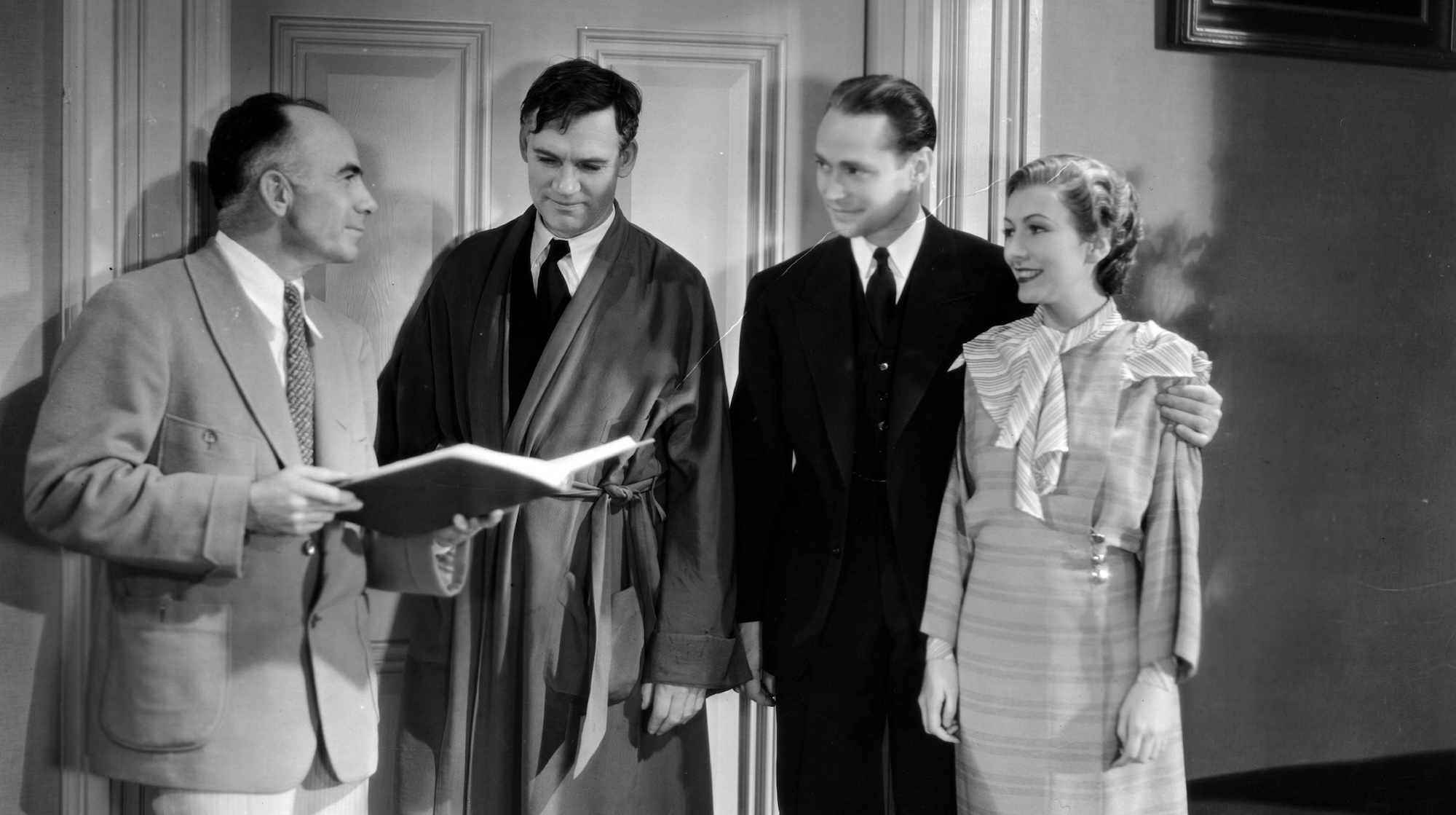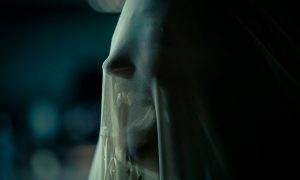
Near the tailend of producer Walter Wanger’s Gabriel Over the White House, an American commander-in-chief sits side by side with the leader of an American gang. The visual and cultural cues of such a scenario might look unfamiliar to modern eyes, but the subtext being conveyed to audiences circa 1933 feels eerily familiar. The self-named Nick Diamond—who we learned earlier in the picture was born with the ethnic-sounding moniker of Antone Brilawski—presents himself as a man about town, a dapper gent with a smart suit and expensive cane. He even quotes the recently incarcerated Al Capone.
And yet, the President of the United States he sits across wouldn’t sound that out of place if he were speaking at last Sunday’s MAGA rally in Madison Square Garden. As the POTUS smirks, “[You are] the story of an immigrant boy who became the most famous man in America. And there are a few good deeds here. You’ve at least rid the country of a number of your own kind, something I’m grateful for.” The American executive then ends his thinly veiled threat by suggesting that the most inexpensive and efficient thing Diamond could do for America is “to eliminate yourself and return to your own country.” Barring that, things might get… violent.
What’s striking about watching this scene more than 90 years after it was released is that the film never wants you to once shudder at its fictional president using the power of the Oval Office like any other autocrat in history. Rather we are expected to revel in his charismatic populism and naked power-grabs, including when he welcomes being called a “dictator” by indignant, and feckless, members of Congress. After all, President Judson Hammond is played by the arresting Walter Huston, who only three years earlier portrayed Honest Abe in 1930’s Abraham Lincoln. And Lincoln, as well as Thomas Jefferson and George Washington, is invoked often in this Depression era fantasy about a strongman coming in and fixing all of America’s then very dire problems.
That this fantasy was so captivating in 1933 to a bipartisan mixture of Americans is also what makes it so illuminating when considering the undying strand of American populism it represents, especially in moments of heightened political tension. And nine decades later, President Hammond’s early 20th century dream is looking more and more like a 21st century reality.
Why You Probably Never Heard of Gabriel Over the White House
Gabriel Over the White House was not made in a vacuum, nor is it an accident if you’ve never heard of it. While technically based on a novel by British author T.F. Tweed—though only nominally so since the original version of the book was set in a futuristic Europe—Gabriel Over the White House was not-so-much speculative fiction as an imaginary wish-list of items that producers Wanger and William Randolph Hearst, yes that notorious Hearst who inspired Citizen Kane, wanted out of a potential Franklin Delano Roosevelt presidency. Many of the problems faced by the fictional Hammond in the movie are echoes of real-world anxieties occurring in the depths of the Great Depression, including the threat of organized crime and Mafia (albeit the “m” word is never said in the film).
Much of the bizarre allure of Gabriel’s fancy stems from the idea of a new American executive not named Herbert Hoover coming in and finding “sensible,” no-nonsense solutions to all of America’s ills—and then slowly convincing himself and his fellow citizens that the best way to implement them is through an unrestrained executive who would declare a state of martial law.
While there are conflicting stories of when studio mogul Louis B. Mayer, head of MGM, got wind of the political tenor in the movie his studio was making, there’s no denying Mayer was a dyed-in-the-wool Republican and supporter of the Hoover administration. So whether he got steamrolled by Hearst’s ample wallet (with Hearst allegedly rewriting much of President Hammond’s demagoguery in the film) or he really only discovered the political contents of the movie after a test screening, the reality is he detested the picture. He made sure it was released in March 1933… after Roosevelt was sworn in.
Furthermore, according to Walter Wanger’s biographer Matthew Bernstein, Mayer ordered the picture be taken “back to the studio, and lock it up!” Although this did not occur before the newly sworn in President Roosevelt reportedly screened the movie several times in his new White House abode, apparently enjoying it immensely. He did so more than posterity, as the film has been largely buried until home media releases at the turn of the century.
The Allure of Gabriel’s America
When Gabriel Over the White House was released, it came at the backend of what could be called Hollywood’s happy fascist era. Like many throughout the Western world who saw economies crater following the stock market crash of 1929—or never recover at all from the First World War—this was a moment of great anxiety and growing disillusionment with the American democratic model.
American journalist and thinker Walter Lippmann told Berkeley in 1933, the same year that Gabriel was released, “It has fallen to us to live in one of those conjunctures of human affairs which mark a crisis in the habits, the customs, the routine, the inherited method of the traditional ideas of mankind. The old relationships among the great masses of the people of the earth have disappeared. The fixed points by which our fathers steered the ship of state have vanished.” A few years before that, legal scholar Felix Frankfurter observed, “Epitaphs for democracy are the fashion of the day.” Political theorist Harold Laski, meanwhile, bleakly quipped in 1932 that “representative democracy seems to have ended in a cul-de-sac.”
This growing cynicism reflected a sense of gnawing despair around the world. Around the same time brownshirts were marching in Munich, and blackshirts had long conquered Rome, large swaths of the American public flirted with imagining alternative forms of government, whether it was some on the far-left romanticizing “Uncle Joe” Stalin and the Soviet Union, or members of the far-right looking enviously at Benito Mussolini’s rise to power in 1920s Italy.
Over the course of Hoover’s first and only term in the White House, stocks lost nearly 40 percent of their value following the 1929 crash, unemployment levels rose from nine to 23 percent before the presidential election of 1932, and the Hoover administration’s reliance on tariffs to counteract the Depression only exacerbated it. Through it all, the American government was refusing to give their fellow citizens much of a helping hand, with Hoover considering government relief a slippery slope “into socialism and collectivism.”
So when a “Bonus Army” of American veterans from World War I—estimated to consist of about 12,000 to 14,000 impoverished citizens who served their country—marched on Washington D.C. in 1932 to demand a bonus they were promised during the war, it should not have been a surprise that Congress refused to pay. Half the protestors went home, but when the other half stayed encamped in the nation’s capital, the U.S. Army was ordered by President Hoover to drive them out, including by use of tear gas and tanks.
America’s Happy Hollywood Fascist
The shadow of the Bonus Army catastrophe hangs heavy, too, over Gabriel Over the White House. In the film, a populist march of the self-described “Army of the Unemployed” is the first major crisis faced by fictional President Hammond, who is advised repeatedly by his cabinet to send in the real Army to rough up these “anarchists.” Yet after the protestors’ populist leader, who leads his men in constant refrains of “John Brown’s body lies a-mouldering in the grave” is murdered by Nick Diamond’s henchmen, the burgeoning American autocrat seizes an opportunity.
Arriving in Baltimore to speak to the so-called mob, the fictitious president comes with promises instead of weapons. Also months before the real New Deal is enacted, he embodies a leader who at last hears his citizens’ pain and offers relief instead of cold comfort. “At one time or another we gave millions of tons of food to the starving Russians, to the starving Chinese, and to the starving Belgians,” Hammond says with disgust to one of his subordinates before going to Baltimore. “Now we can feed our own people.”
On paper this suggests a reasonable pivot of American policy during a time of crisis. His promises to the unemployed at the capital’s doorstep, indeed, sound faintly similar to the New Deal policies pursued by Roosevelt… yet they come even this early in the picture twinged with a militaristic bent.
“I propose creating an army that will be known as the Army of Construction,” Hammond tells the crowd. And if Congress will “give me these funds tomorrow, I shall immediately open the first Construction Army recruiting station here in Baltimore, and you shall be my first soldiers.” Therein lies the understated menace in the film, with the POTUS not envisioning American relief during the Depression as an opportunity to help the unemployed, but to radicalize and nationalize them into a literal fighting force loyal directly to him. In this scene, the film daydreams of a strongman who could commandeer a populist, rightfully angry movement and turn it toward his own purposes.
This is borne out in the following sequence, which is perhaps the centerpiece of the film. After recruiting the unemployed as his own “soldiers” who will work for the state, Hammond subsequently fires his entire cabinet, which enrages members of his own party enough in Congress for the U.S. House to begin, vaguely, drawing up articles of impeachment.
It is not clear what those articles would be over, per se, but it creates a set-piece opportunity where Hammond unexpectedly shows up at Capitol Hill during a full session to make an impromptu address to one chamber of Congress. At first, he demands in-person $4 billion to fund his Construction Army. And when politicians from his own majority balk, Hammond substitutes that request with another.
“I ask you gentlemen to declare a state of national emergency and to adjourn this Congress until normal conditions are restored,” Hammond announces in his most bellicose tenor. “During that period of that adjournment, I shall assume full responsibility of the government.”
When all elected members of another branch cry at how this reeks of dictatorship, Hammond bellows in what is clearly intended to be an applause line for the audience in the theater, “Senator Langam, words do not frighten me!” He eventually adds that Congress has already failed American democracy: “You turned your backs. You closed your ears to the appeals of the people. You’ve been traitors to the concept of democracy on which this government was found. I believe in democracy as Washington, Jefferson, and Lincoln believed in democracy. And if what I plan to do makes me a dictator, then it is a dictatorship that is based on Jefferson’s definition of democracy; ‘a government for the good for the greatest number!’”
By the end of the sequence, Hammond has sweepingly declared martial law and assumed the sole power of the legislature and executive. Soon enough, it seems he’s commandeered the authority of the judiciary as well, since he shortly thereafter creates “a federal police force” that nominally is to be used to face another major threat in 1930s America: organized crime. Yet the implicit racism of the way Hammond sneers “your kind” to Diamond in an aforementioned scene foreshadows how disquieting the federal police force’s solutions really are. They drive WWI-era tanks through American streets to round up ostensibly only American gangsters, who are then tried not by a court of fellow citizens, but by a military tribunal.
As Diamond and his cohorts’ sentences are handed down by three of Hammond’s sharply uniformed officers, one boasts, “We have in the White House a man who has enabled us to cut the red tape of legal procedures and get back to first principles. An eye for an eye, Nick Diamond, a tooth for a tooth. A life for a life.” The stereotyped Italian Americans are then lined up against a wall overlooking the Statue of Liberty in New York harbor and gunned down by men who earlier in the picture were singing “Glory, Glory, Hallelujah.”
A Popular Fantasy in Dark Times
All of these rosy visions of unchecked executive authority and supposedly benevolent dictatorship are couched in a silly, misbegotten film. Gabriel Over the White House director Gregory La Cava’s career is largely defined by comedies like My Man Godfrey (1936) and Stage Door (1937), and much of the setup of Gabriel feels like a bizarro forerunner of Frank Capra’s later triumphs. The “Gabriel” of the title even comes from a conceit that wouldn’t feel out of place in Bedford Falls, with President Hammond initially being introduced as an empty partisan suit reminiscent of Warren G. Harding, right down to having a mistress pretending to be his secretary (this was also a pre-Code, pre-censorship film).
But after a car accident while joy-riding in his first hundred days, Hammond is depicted as being touched by the angel Gabriel and divine providence itself, shunning his mistress, and becoming the first American president since presumably Huston’s previous turn as Abe Lincoln to give a damn about the American people.
And truthfully many of the problems he faces are reflected in the real-world troubles of 1933. Roosevelt, again, pursued public works and government aid to get Americans back on their feet and away from starvation; the 18th Amendment (Prohibition) was repealed, in part, to curb the rise in organized crime and racketeering. And Hammond’s fears of another world war escalating out of Europe proved only too prescient. But how Hammond achieved his agenda—unlike Roosevelt—is where the movie offers a chilling warning about where American impulses can lie when desperate, or desperately misled. They put their faith in a raging, anti-democratic populist.
Consider that the next European war started also becoming close to inevitable in 1933, because it was the same year that the newly appointed German Chancellor Adolf Hitler had the Reichstag burned and used the arson to pass the Reichstag Fire Decree, which gave the budding dictator the power of eliminating his political enemies. Ostensibly, they were all troublesome communists that he was having executed in a state of emergency, a bit like Hammond and his hated immigrant racketeers… but of course it did not stop there as his power became absolute.
It’s worth noting that what really curbed the thirst for American fascism in the 1930s was Roosevelt getting the American government to work again—through legal methods—for its citizens. Even then, early supporters like radio firebrand Father Charles Coughlin eventually lost faith in Roosevelt and democracy as he drifted evermore toward the far-right, and Nazi sympathies, even spreading Hitler-inspired conspiracy theories about big banks and Jewish people throughout the decade.
Meanwhile American fascist sympathies in the margins persisted, and even crescendoed into a full-blown Nazi rally at Madison Square Garden, organized by the German-American bund organization. It came complete with Antisemitic speakers referring to the New Deal as “the Jew Deal” and fermenting hatred while saying the current Democratic administration was really a Bolshevik-Jewish American takeover.
This dark side of American populism has always been there, and nearly a hundred years after Gabriel Over the White House gave it a glossy Hollywood sheen, it persists in vivid, horrifying technicolor.
The post Hollywood’s Forgotten Love Letter to American Fascism in the 1930s appeared first on Den of Geek.



